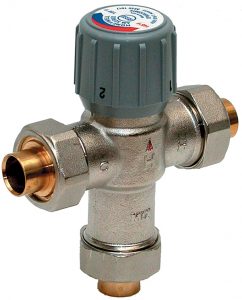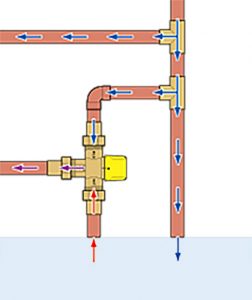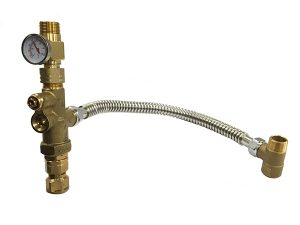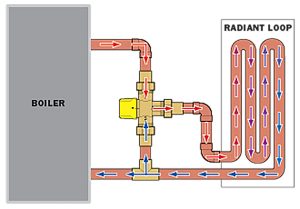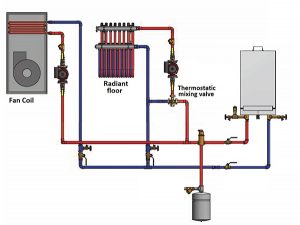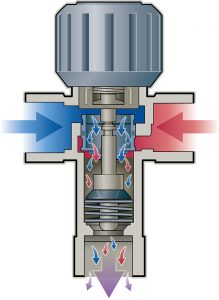
Thermostatic mixing valves: Applications in plumbing and hydronic heating
May 30, 2018 | By Robert Waters
Are thermostatic mixing valves for plumbing or hydronic heating? Well it turns out they are for both. The same valve can be found in the domestic hot water supply system, as well as the control valve for a hydronic heating application. This makes these important pieces of equipment real workhorses of the mechanical industry, a crossover product that is equally as important for both sectors.
Thermostatic mixing valves are used in residential, commercial and institutional applications for both plumbing and hydronic heating. The primary function of these valves is to control the output water temperature to either a domestic hot water supply system, or provide a low temperature supply to a radiant floor heating system. Often the exact same physical valve can be used for both applications.
There are however many different types, sizes and configurations of valves that are designed for specific applications. On the plumbing side, there are many unique applications that require very specific thermostatic valves. For most hydronic applications, thermostatic valves are typically three-way valves used for small- to medium-sized projects.
Plumbing code changes adopted in most jurisdictions across Canada now require the control of hot water temperature through the use of thermostatic mixing valves. Water temperatures must not exceed 49C (120F) supplied to all fixtures. This requires that a mixing valve certified to CSA Standard CAN/CSA B125-01 must be installed on the hot water distribution line as close as practical to the top of the water heater tank and factory set at 49C.
Where site conditions such as long runs of piping could cause the water temperature delivered to a faucet to be significantly lower than 49C then a point of use mixing valve certified to CSA Standard B125-01 must be installed in lieu of the valve being installed at the tank.
To understand these code requirements, it is important to understand why temperature control is so important in a domestic hot water system. A thermostatic mixing valve provides important benefits of safety and comfort to the building occupants. Domestic hot water potentially exposes building occupants to two very specific hazards: the threat of scalding from excessively hot water, and the potential for Legionella bacteria growth.
Scalding from the exposure to very hot water involves the destruction of skin cells and sometimes the underlying structures of muscle. Scalding can produce burns just as damaging as a burn from fire. Research has shown that scalding burns from hot water can occur in just seconds–even less for small children with thin tender skin. Also, the slow reaction time of the elderly and the handicapped make them particularly vulnerable to serious hot water burns.
A water temperature of 60C (140F) can cause a third-degree burn on adults in five seconds, and with children of 0 to five years old in three seconds. To prevent scalding, the solution is to keep the water temperature below 49C.
Legionnaire’s disease is a type of pneumonia that is caused by the common bacterium Legionella. Both the disease and bacterium were first discovered in 1976, when an outbreak at an American Legion convention led to 29 deaths.
When Legionella is introduced to a plumbing system, these bacteria can reproduce rapidly. Water temperatures between 20C (68F) and 49C (115F) in a domestic water system provide ideal conditions for bacterial growth. The bacterium exists on the inside of pipes and is frequently found in the scale and sediment of water heater tanks. The most widely accepted and preferred method of preventing Legionella is to maintain the hot water system storage temperature continually at or above 60C (140F) and no lower than 55C (131F).
So what should be done? Turn down the water heater to a lower temperature to prevent hazardous scalding, but risk bacteria growth? Turn up the temperature to prevent the potential for Legionella bacteria growth, but risk scalding? Neither is a good choice.
It is easy to see now why the plumbing code requires the use of a thermostatic mixing valve. It is the perfect way to combat both of these serious issues and provide the end user with a comfortable and safe hot water supply.
The thermostatic mixing valve neutralizes both threats by allowing the water heater to be set to a high enough temperature to reduce the threat of bacteria growth, yet the mixing action maintains the appropriate outlet water temperatures to the fixtures and allows occupants to use the sinks, showers or tub with less fear of scalding.
When using a mixing valve, an additional benefit to the end user is more useable hot water capacity. With the water stored at the higher temperature of 60C, and then mixing it down to 49C at the outlet, the result is that there is an increase in the usable hot water supply by approximately 50 per cent versus just keeping the tank set at 49C. This has the effect of turning the capacity of a 40-gallon tank into the equivalent of a 60-gallon tank. This higher amount of delivered hot water from the tank means the end user is less likely to run out of hot water.
There are two general types of thermostatic mixing valves used in plumbing systems. A system device is designed to limit the water temperature at the source of hot water for distribution to a supply system and is installed close to the outlet of the water heater. System valves are available in a wide variety of sizes for residential and commercial applications from ¾ inches to 3 inches.
Some manufacturers make residential tank kits that include the mixing valve, connection fittings and flexible cold water bypass line. These kits make it simple to connect to the top of a conventional tank type water heater.
A point of use device is designed to limit the water temperature to a single or group of fixtures. This is typically attached directly to the shower, or under the sink, to control the water temperature and provide anti-scald protection.
There is a specialty type of emergency thermostatic mixing valve, which is specifically designed to provide tepid water for emergency eyewash or shower drench applications. The current ANSI standard calls for emergency eyewash and drench showers to deliver tepid water for 15 minutes. This assures that a user won’t be subjected to very cold water and possibly hypothermia, or very hot scalding water.
In hydronic heating applications, a thermostatic mixing valve provides a simple solution for delivering lower supply water temperatures to a radiant floor heating system in residential and small commercial applications. Whenever radiant floor heating is combined in the same system with higher temperature distribution systems, such as fan-coils or baseboard radiators, a mixing valve is essential.
The mixing valve provides the ability to have the heat source (boiler or water heater) set at a higher temperature to satisfy the high temperature loads and then have the radiant circuit supplied with a lower water temperature through the mixing valve.
An example would be the very common hybrid system with radiant floor heating in the basement and a fan coil to heat the upper floors. This is a two temperature system with the high mass radiant floor typically requiring a supply water temperature of between 35C to 45C, and the fan coil requiring a much higher temperature of between 65C to 75C. If you try and supply only one temperature to both areas you will create big problems. With a high supply temperature you will dramatically overheat the floor, causing potential damage or difficult to control heat output. With a low supply temperature you will not get enough heat output from the fan coil.
The solution is to divide the system into two circuits with two pumps and one thermostatic mixing valve (see piping diagram). The fan coil will get high temperature water directly from the heat source and the radiant floor will get lower temperature water coming from the thermostatic valve.
It is very important to make sure that the circulating pump for the radiant circuit is installed downstream of the mixing valve, otherwise you will not get sufficient flow through the radiant loops. Remember that water will always take the path of least resistance and if the pump is upstream of the thermostatic valve, it will flow right through the valve and not go through the loops.
It is also important never to try and make this system work with only one pump for both loads. Keep the loads separate so both get the proper flow they require. Use spring check valves on both supply lines to prevent thermosiphoning to zones above the mechanical room. To ensure accuracy in adjusting the temperature setting, make sure that the hot water supply temperature to the mixing valve is at least 5C (10F) hotter than the desired temperature of the mixed water.
Adding a basement radiant floor heating system to a water heater is a very popular option for many homes. What is not to love about a warm comfortable radiant heated basement? Even with only this single temperature radiant floor heating circuit, it is still very important to have a thermostatic valve. With the code requiring the water heater to be kept at 60C, the water temperature must be mixed down before it enters the floor. Therefore it is essential to install a thermostatic valve upstream of the radiant floor heating pump.
The primary function of a thermostatic mixing valve in a heating application is to regulate the water temperature on the supply side of the distribution system, but in many systems it is not the only function of the mixing device. In systems using “conventional” non-condensing boilers, the thermostatic mixing valve can also ensure that the boiler return temperature remains high enough to prevent sustained flue gas condensation.
When utilizing a mixing valve for this purpose, some of the hot supply water mixes with cooler water returning from the distribution system, the blend is directed back to the boiler. The objective is to boost the boiler inlet temperature high enough to prevent flue gas condensation, which usually means above 55C (131F). This return water boosting is never required for a condensing boiler, and with more and more condensing boilers being installed today, this is not an application that will be seen very often anymore.
There are three main technologies used for thermostatic mixing valves: wax element technology, bi-metal strip, and liquid filled technology. The most common type seen in residential and small commercial applications, for both plumbing and heating, is the wax element technology. The wax element provides high accuracy, fast response and extremely long life, with few moving parts.
A thermostatic mixing valve utilizes three major components for its operation: some sort of spindle or shaft, a thermal element and a return spring. The return spring provides an upward return force to the thermal element. The thermal element acts as a movable unit, which reacts to changes in temperature, opening ports to change the water flowing between the hot and cold water inlets.
When tempered water is in use, the thermal element senses the outlet temperature and positions a seat assembly, which controls the flow of hot and cold water supplied to the mixed water port. If the mixed outlet temperature increases, the thermostat will expand, moving the seat assembly to allow more cold water in and at the same time restricting the hot water inlet port.
Conversely, if the mixed outlet temperature decreases, the thermostat will contract, allowing the more hot water in and restricting the cold water inlet port. In both cases the mixed outlet water temperature is automatically and continually maintained at the pre-set temperature. Most valves will have a safety feature which shuts off the hot or cold inlet port in the event of a cold or hot water supply failure. The valve will have a mechanical adjustment in the form of a dial or set screw at the top, which permits the user to select the desired outlet water temperature within range of the valve.
This will have to be set up at the time of system commissioning and is much easier do if a temperature gauge is installed in the mixed water line downstream of the valve. Some valves on the market are available with a built in thermometer to make set up very easy.
So the answer is clear: thermostatic mixing valves are essential for both plumbing and hydronic heating. Make sure you use them properly to protect your customers and protect their floor systems, while providing optimum performance from the hot water supply and the heating system. <>

